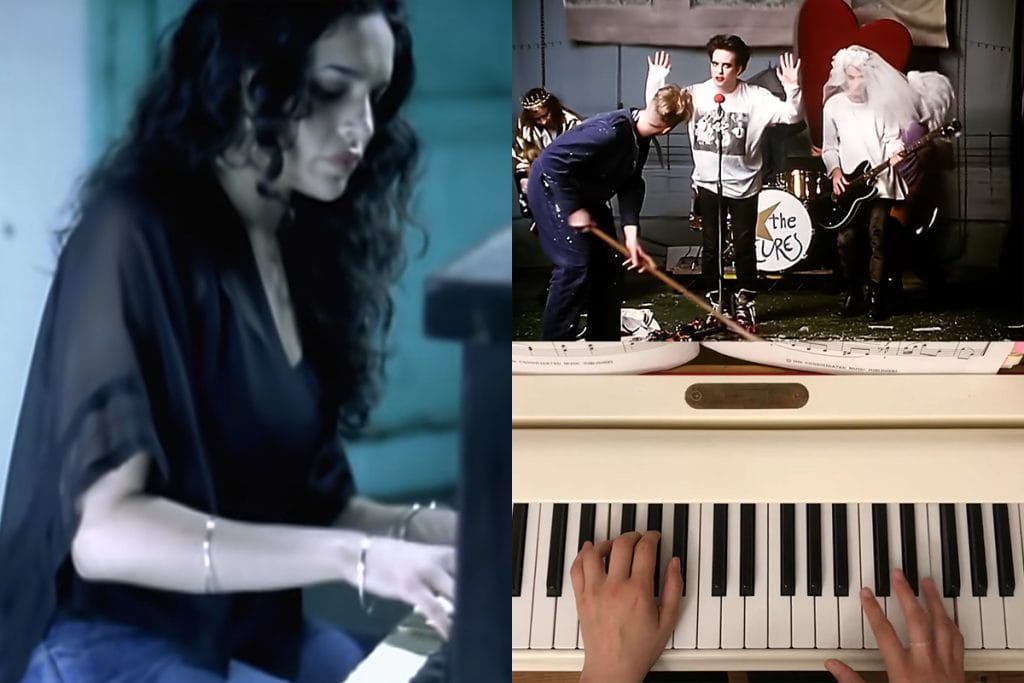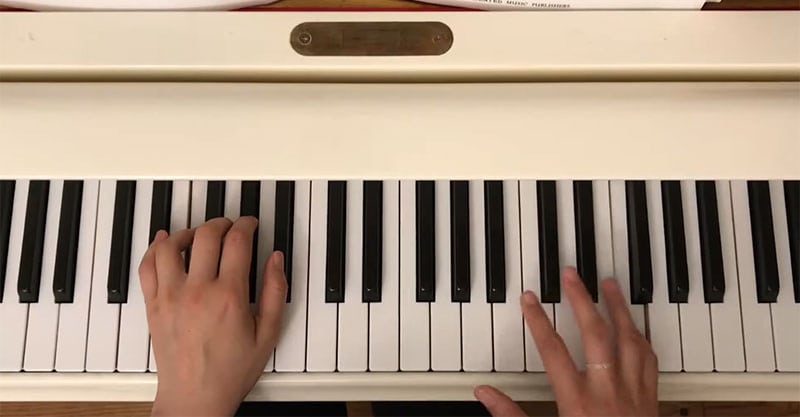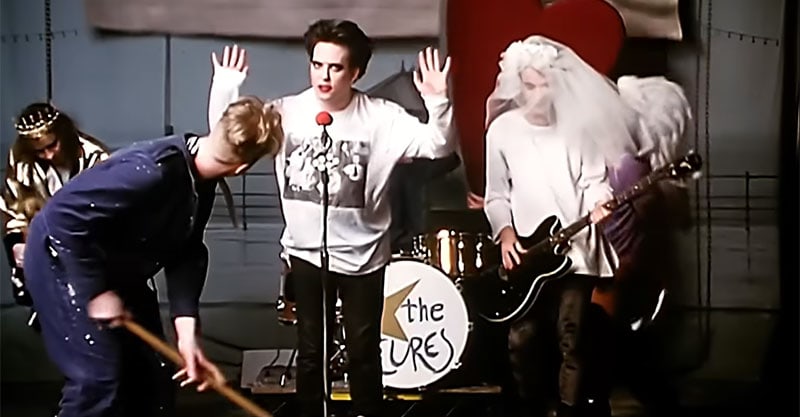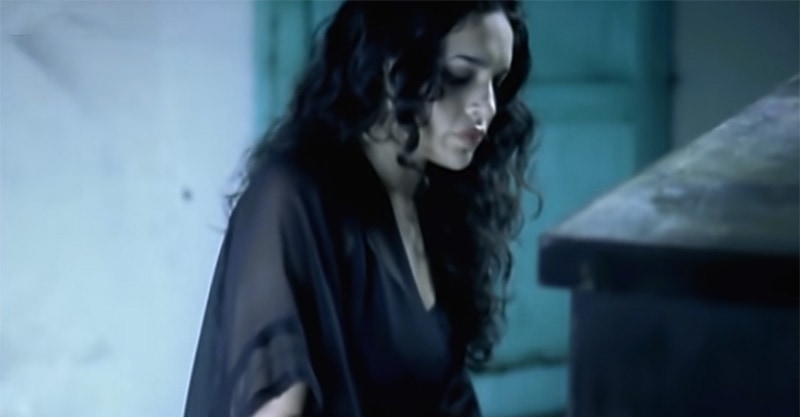
The ternary form is most observable in huge swaths of classical music – Mozart, Beethoven, Chopin, Handel, and others.
The three-part musical form isn’t too hard to understand. There’s the first A section, the B section, which usually introduces something contrasting or very different, and the closing A section, which returns to more familiar musical territory (but isn’t necessarily a simple repeat of the first A section).
Within these confines, which are honestly open to interpretation, many subtle and not-so-subtle variations exist. In this guide, we’ll be looking at an array of ternary songs with the ABA form as well as the AABA form.
“Andante (In Eb Major)” by Wolfgang Amadeus Mozart
Song year: 1778
Wolfgang Amadeus Mozart’s “Andante (In Eb Major)” is said to have been written by the Classical composer himself while he was still a child. It’s a short piece, but masterful and beautiful, and it just so happens that it’s an excellent example of the ABA form as well.
The B section is a clear deviation from the A section, though in this case, I would not say it’s a huge departure. It’s just different enough to be noticeable.
While it is in an awkward key signature (come on, Eb?) This is an excellent selection for beginner musicians to study, learn from, and internalize in understanding the ternary form. Just don’t get frustrated with yourself if you can’t play it first try.
“Nocturne No. 4 in F Major, Op. 15, No. 1” by Frédéric Chopin
Song year: 1832
Romantic period Polish composer and virtuoso pianist Frédéric Chopin is considered by many to be a matchless genius. Chopin was greatly inspired by Polish folk music, and the likes of J. S. Bach, Mozart, and Schubert.
This “nighttime music” number opens with a fitting, calming melody – just the thing you would expect from a nocturne.
Not one to veer too far from his intensity, the B section of “Nocturne No. 4 in F Major, Op. 15, No. 1,” however, takes a turn toward the aggressive and menacing. But let’s be clear – that’s what’s cool about this piece, and something like this could work very well in a symphonic metal tune, don’t you think?
The song does return to dreamier territory in the final A section, though, offering needed closure, and perhaps a chance to dose off to sleep for real.

“Messiah: The Trumpet Shall Sound” by George Frideric Handel
Song year: 1741
German-British Baroque composer George Frideric Handel is remembered most for his anthems, operas, oratorios, organ concertos, and concerti grossi.
“Messiah: The Trumpet Shall Sound” is an English oratorio and a variation of an aria, which rose to prominence during the Baroque period.
Not surprisingly, the trumpet is one of the focal points in this composition (scriptures are rife with references to trumpet). The first A section begins triumphantly and regally, pointing to the great divine.
The contrasting B section moves to a minor key signature and is very distinct from the opening section.
The song doesn’t disappoint, however, returning with a triumphant ending befitting royalty.
“Symphony No. 47 ‘The Palindrome’” by Joseph Haydn
Song year: 1772
The third movement of “Symphony No. 47” features “dance music” that’s in the ternary form. It effectively takes the structure of minuet–trio–minuet.
It’s nicknamed “The Palindrome” because it takes the AABBAA form – it’s the same forwards as it is backward (which is what a palindrome is). The words “eye,” “civic,” and “radar” are all examples of palindromes.
This specific form counts as an instance of compound ternary form, which can also be found in an array of other classical compositions.
“Piano Sonata No. 16 in C Major, K. 545” by Wolfgang Amadeus Mozart
Song year: 1805
In Mozart’s own words, “Piano Sonata No. 16 in C Major, K. 545” was composed “for beginners.” The song was not published in Mozart’s lifetime, and the exact details of the composition are unknown. That said, the song is widely known today.
The sonata form was originally thought to be a variant of the binary form, but through modern eyes it is seen as three distinct sections, making it ternary.
The typical performance of “Piano Sonata No. 16” takes 11 minutes, though, in the video above, the song is captured in a little over five minutes.
While I get that the song is in C major and it primarily consists of white keys, I’m not sure that I agree with Mozart’s assessment that it’s for beginners. It does make for a great tune to practice your scales though.

“Polonaise in A Major, Op. 40, No.1 ‘Military Polonaise’” by Frédéric Chopin
Song year: 1838
“Polonaise in A Major, Op. 40, No. 1 ‘Military Polonaise’” (sounds like pasta… maybe I’m just hungry) was composed by Chopin in 1838 and dedicated to Polish composer Julian Fontana. Polish-American pianist Arthur Rubinstein called “Polonaise in A Major” a “symbol of Polish glory.”
This piece is a great example of the ternary form, as it is obvious where the changes happen (listen for yourself).
The song opens in the key of A major, shifts to D major in the middle section, then returns to the opening with almost no changes.
“Prelude, Op. 28, No. 15 ‘Raindrop’” by Frédéric Chopin
Song year: 1839
Chopin’s “Raindrop Prelude” is one of his most famous works with a length of five to seven minutes. That makes it the longest of his preludes.
The reason it’s called “Raindrop” is because of the repeated Ab note, which sounded like raindrops to listening audiences. All evidence seems to point to the fact that Chopin was inspired by nature when he wrote this piece (including, of course, drops of water).
Again, there is a relatively clear demarcation between the sections. The song opens in Db, moves to the middle section in C# minor, and then repeats the original theme at the end.
These sections create such a strong contrast that Frederick Niecks compared the piece to falling into a nightmare and then waking up to nature’s beauty.
“Prelude in C-Sharp Minor, Op. 3, No. 2” by Sergei Rachmaninoff
Song year: 1892
Rachmaninoff’s “Prelude in C-Sharp Minor, Op. 3, No. 2” is among his most famous pieces, and among the first he ever composed. The 62-bar prelude is in ternary form, and it is sometimes called “The Bells of Moscow.”

“Twinkle, Twinkle, Little Star” by Jane Taylor
Song year: 1806
Many children’s songs, including “Twinkle, Twinkle, Little Star” (arguably) take the ternary form.
At the core, it’s a very simple song, and while there are always interesting ways of turning it into a more sophisticated work, the melody mostly consists of repeating ascending and descending patterns. So, it’s certainly easy enough for beginners to learn.
The A section begins with “Twinkle, twinkle, little star,” the B section is “Up above the clouds so high…,” and of course, the song returns to “Twinkle, twinkle, little star” after.
How many times you repeat each part is up to you, though.
“Baa, Baa, Black Sheep,” is just the same melody with different lyrics.
“Glasgow Kiss” by John Petrucci
Song year: 2005
Virtuoso American guitarist John Petrucci is known for many things, but he is probably best known as the founding member of the New York progressive metal outfit Dream Theater.
If it wasn’t enough that Dream Theater has maintained a prolific release scheduled from 1989 through to 2021 (with no signs of stopping), Petrucci also has multiple releases as a solo artist, with Liquid Tension Experiment, with Jordan Rudess, and more.
Instrumental rock may well be one of the toughest genres to do well, and with “Glasgow Kiss” Petrucci demonstrates that he knows how to keep a listening audience engaged.
Now, if it’s not your style, you might pass up “Glasgow Kiss” for something else that caters to your musical tastes, but the song is considered a masterpiece by some. If nothing else, it does feature some brilliant guitar work.
The song structure fits the ABA form, if only loosely. There’s a theme that emerges in the A section, there’s a contrasting B section with a different feel, and there’s a reprise of the original theme in the closing A section.
Again, while there might be some deviations from the form, overall, it is a good example of ternary song structure.
“Over the Rainbow” by Harold Arlen & E.Y. Harburg
Song year: 1939
Strictly speaking, “Over the Rainbow,” of The Wizard of Oz and Judy Garland fame, is in AABA form (and so are all songs that follow).
This form is well worth studying, however, as it dominated the 30s to the 50s (as well as huge swaths of the Great American Songbook) until rock and roll came along and changed the whole game.
“Over the Rainbow” would go on to become Garland’s signature song. She performed it for the better part of 30 years, always making sure to stay close to the original performance and the character of the protagonist in The Wizard of Oz, Dorothy.

“Yesterday” by The Beatles
Song year: 1965
Credited to the Lennon-McCartney dynasty, The Beatles’ “Yesterday” is effectively a McCartney solo ballad of sadness. Spawning over 2,200 cover versions, it is easily one of the most reprised songs in existence. Yeah, people like it, I guess…
McCartney reportedly put the whole thing together in a dream, believing that he may have ripped someone off. No one ended up claiming it as their own, though, so McCartney was free and clear to record and release it.
The Beatles certainly weren’t shy about their musical explorations, but “Yesterday” was so different from their other tunes that it was not released as a single in the UK until much later.
“Friday I’m in Love” by The Cure
https://www.youtube.com/watch?v=mGgMZpGYiy8
Song year: 1992
The Cure’s “Friday I’m in Love” was indeed intended as a happy-go-lucky track, as singer and lyricist Robert Smith confirms.
Smith initially thought he’d stolen the chord progression from somewhere (much like McCartney’s story from earlier, isn’t it?). Having played it for everyone he could think to play it for, he finally accepted that he was the one to come up with the melody.
Said chord progression revolves primarily around the I, IV, V, and vi chords, though, which are common in any pop song, especially nowadays. I’m not entirely sure what Smith was worried about, but I guess he must have known the song’s hit potential, which he was right about.
“Don’t Know Why” by Norah Jones
tO4dxvguQDk
Song year: 2002
The song, “Don’t Know Why,” was originally written and composed by Jesse Harris for the 1999 release, Jesse Harris & the Ferdinandos.
Norah Jones’ version ended up being the debut single from her debut album, Come Away with Me, in 2002. It did very well for her, reaching number 30 on the US Billboard Hot 100, and earning her three Grammy Awards in 2003.
It wasn’t just the song that led to success, though, as among other things, Jones’ skillful and mature piano playing was also praised, drawing comparisons to American pianist Floyd Cramer.

“Let’s Call the Whole Thing Off” by George Gershwin & Ira Gershwin
https://www.youtube.com/watch?v=BVuA6haPDWk
Song year: 1937
“Let’s Call the Whole Thing Off” was written by George and Ira Gershwin for the 1937 film, Shall We Dance. Fittingly, it was introduced by one of the greatest popular music dancers of all time, Fred Astaire, along with actress, dancer, and singer Ginger Rogers. The dance duet was famously performed on roller skates.
The song is also famous for comparing English and British pronunciations of various words, which also served to identify class differences in the 30s.
“Someone to Watch Over Me” by George Gershwin, Ira Gershwin & Howard Dietz
Song year: 1926
“Someone to Watch Over Me” was written for the 1926 musical, Oh, Kay!. The part was sung by English actress, singer, dancer, and musical comedy performer Gertrude Lawrence while holding a ragdoll.
The popular musical took New York by storm with over 200 performances, and it did just as well in London in 1927.
While the original was written as an up-tempo jazz tune, throughout the 30s and 40s it was recorded by various singers as a ballad, which became the standard.
“Anything Goes” by Cole Porter
Song year: 1934
Cole Porter’s “Anything Goes” was written for his eponymous 1934 musical, Anything Goes. Loaded with Depression-era humor, you would expect the song to go over like a lead balloon in the modern era.
Yet the song seems to have inspired countless artists, and the likes of Frank Sinatra, Ella Fitzgerald, and Tony Bennett would go on to record their respective versions. There was also a Tony Bennett and Lady Gaga version released in 2014.
As memory serves, the song was used in a commercial not that long ago too…
Best Ternary Songs In ABA Form, Final Thoughts
We hope you’ve gained a better understanding of the ternary form. While there are fewer songs today that take the ABA and AABA forms, if you listen for them, you can still occasionally find them. Either way, the forms served a very important purpose in classical music and pop and jazz standards.
Songs can take many other forms, especially today. We encourage you to keep studying and make it your goal to be able to identify and use many forms in your performance, recording, and songwriting efforts. Good luck!